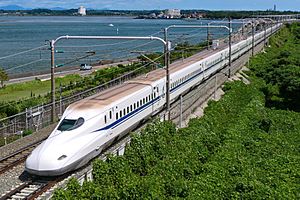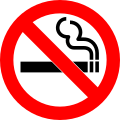Nozomi (train) facts for kids

N700A Series Nozomi, September 2021
|
|
| Overview | |
|---|---|
| Service type | Shinkansen |
| First service | 1934 (Express) 1992 (Shinkansen) |
| Current operator(s) | JR Central, JR West |
| Route | |
| Start | Tokyo |
| End | Hakata |
| Line used | Tokaido Shinkansen San'yō Shinkansen |
| On-board services | |
| Class(es) | Green/standard |
| Catering facilities | Trolley service |
| Technical | |
| Rolling stock | N700 series, N700S series |
| Track gauge | 1,435 mm (4 ft 8 1⁄2 in) standard gauge |
| Electrification | 25 kV AC overhead |
| Operating speed | 300 km/h (185 mph) |
The Nozomi (which means "Wish" or "Hope" in Japanese) is the fastest train service in Japan. It runs on the Tokaido and San'yō Shinkansen lines. These trains only stop at the biggest stations.
Between Shin-Ōsaka and Hakata, Nozomi trains can reach amazing speeds of 300 km/h (186 mph). A trip from Tokyo to Osaka is about 515 kilometres (320 mi) long. The fastest Nozomi train completes this journey in just 2 hours and 21 minutes.
If you travel from Tōkyō all the way to Hakata, the fastest trip takes 4 hours and 46 minutes. Nozomi trains stop at fewer stations than other Shinkansen trains like the Hikari and Kodama.
On the Tōkaidō Shinkansen, between Tokyo and Shin-Ōsaka, Nozomi trains only stop at Shinagawa, Shin-Yokohama, Nagoya, and Kyōto. On the Sanyō Shinkansen, between Shin-Ōsaka and Hakata, all Nozomi trains stop at Shin-Kobe, Hiroshima, Okayama, and Kokura. Some trains might also stop at a few more stations.
It's important to know that if you are a tourist using a Japan Rail Pass, you cannot use the Nozomi service. This is one of only two Shinkansen services that are not included with the pass. The other is the Mizuho service on the San'yo Shinkansen.
Contents
Where Nozomi Trains Stop (May 2019)
This section shows you where Nozomi trains usually stop.
Legend
| ● | All trains stop |
|---|---|
| ○ | Some trains stop |
| △ | Few trains stop |
Note:
- Some trains start or end their journey at Nishi-Akashi, Himeji, Okayama, or Hiroshima.
- Some trains start or end their journey at Nagoya.
This table shows the main stopping patterns. During holidays or busy travel times, extra Nozomi trains might run with different stopping patterns.
| Station | Distance (km) (from Tokyo) |
Tokyo - Hakata1 | Tokyo- Shin-Osaka2 |
Nagoya - Hakata |
|---|---|---|---|---|
| Tokyo | 0.0 | ● | ● | |
| Shinagawa | 6.8 | ● | ● | |
| Shin-Yokohama | 25.5 | ● | ● | |
| Nagoya | 342.0 | ● | ● | ● |
| Kyoto | 476.3 | ● | ● | ● |
| Shin-Ōsaka | 515.4 | ● | ● | ● |
| Shin-Kobe | 548.0 | ● | ● | |
| Nishi-Akashi | 570.2 | △ | - | |
| Himeji | 601.3 | ○ | - | |
| Okayama
align=center|676.3 |
● | ● | ||
| Fukuyama | 733.1 | ○ | ○ | |
| Hiroshima | 821.2 | ● | ● | |
| Tokuyama | 903.5 | ○ | - | |
| Shin-Yamaguchi | 944.6 | ○ | ○ | |
| Kokura | 1013.2 | ● | ● | |
| Hakata | 1069.1 | ● | ● |
The Trains Themselves (Rolling Stock)
"Rolling stock" is a fancy way to say the trains that are used for the Nozomi service.
Current Trains
- N700 series (running since July 2007)
- N700S series (running since July 2020)
Older Trains
These trains used to run as Nozomi services but are no longer used for this route:
- 300 series (from March 1992 to March 2012)
- 500 series (from March 1997 to June 2008)
- 700 series (from March 1999 to March 2020)
How the Trains are Set Up (Formations)
Nozomi trains have 16 cars. Car 1 is at the Hakata end of the train, and Car 16 is at the Tokyo end.
N700 series and N700S series Trains
These tables show what each car is like. "Green" cars are like first class, with more comfortable seats. "Standard" cars are regular seats.
All cars on these trains are non-smoking, except for special enclosed smoking rooms in cars 3, 7, 10, and 15.
700 series Trains (No longer used for Nozomi)
This is how the older 700 series trains were set up.
History of the Nozomi Service
Early Express Trains
The name Nozomi was first used way back in 1934. These were long-distance express trains that ran between Busan (in what was then Japanese-occupied Korea) and Mukden (now Shenyang) in a place called Manchukuo (now part of China).
By 1938, these trains went even further, all the way to Hsinking (now Changchun). The journey from Busan to Hsinking was about 1,530 km (950 miles) and took over 29 hours! The trains were stopped between 1943 and 1944.
Modern Shinkansen Services
The Nozomi Shinkansen (bullet train) service began on March 14, 1992. The first trains used were the new 300 series, which could go up to 270 km/h (168 mph).
In March 1997, the even faster 500 series trains were introduced. These trains could reach a top speed of 300 km/h (186 mph) and made the trip between Shin-Osaka and Hakata in just 2 hours and 17 minutes.
Later, 700 series trains started running as Nozomi services in 1999. Then, the N700 series trains began service on July 1, 2007. By March 13, 2010, all regular Nozomi trains going all the way from Tokyo to Hakata were N700 series trains. By March 17, 2012, all Nozomi services, even shorter ones, were operated by N700 series trains.
See also
 In Spanish: Nozomi (Shinkansen) para niños
In Spanish: Nozomi (Shinkansen) para niños
- List of named passenger trains of Japan









